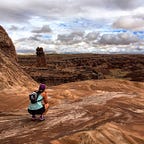Geology of the Ruby Mountains
The complex history of Nevada’s hidden gem
Located just south of Elko, Nevada, the Ruby Mountains rise to 11,387 feet, stretching over 6,000 feet above the basin floor. Both impressive and unique, these mountains were misnamed by early explorers for the abundance of garnets, a sometimes red silica-bearing mineral that is confused with rubies which are the gem form of the mineral corundum.
The Ruby Mountains have a ton to offer to outdoor enthusiasts, including:
- Ten peaks above 10,000 feet including the highest peak, Ruby dome which reaches 11,387 feet [1]
- The famous Terminal Cancer Couloir, a 14 ft wide perfectly straight shoot sought out by thrill-seeking backcountry skiers.
- Home to one of the largest mule deer populations (~12,000) [2]
- An escape from the heat. The Ruby Mountains collect moisture and their high elevation offers cooler temperatures and more diverse fauna relative to other parts of the eastern Great Basin of Nevada
To a geologist, the Ruby Mountains are an example of a metamorphic core complex and tell a tale of metamorphism, granitic intrusion, uplift, and glaciation.
